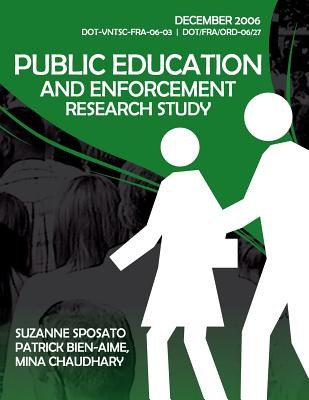
- We will send in 10–14 business days.
- Author: U S Department of Transportation
- Publisher: CreateSpace Independent Publishing Platform
- Year: 2013
- Pages: 124
- ISBN-10: 149470756X
- ISBN-13: 9781494707569
- Format: 21.6 x 28 x 0.7 cm, softcover
- Language: English
- SAVE -10% with code: EXTRA
Public Education and Enforcement Research Study (e-book) (used book) | bookbook.eu
Reviews
Description
The Public Education and Enforcement Research Study (PEERS) was a collaborative effort between the Federal Railroad Administration, the Illinois Commerce Commission, and local communities in the State of Illinois. The purpose of the project was to promote safety at highwayrail intersections by reducing incidents, injuries, and fatalities through new technologies and methodologies. The role of the John A. Volpe National Transportation Systems Center was to monitor and evaluate highway-rail intersections in Illinois communities using video data collection while the communities conducted education and enforcement campaigns. The data collection and analysis efforts focused on three highway-rail intersections in Arlington Heights, IL. The effectiveness of the programs was determined by counting the number of motorists and pedestrians that violated the crossing warning devices during three project phases. These violations were divided into three types based on highway-user assumed risk. The crossings in Arlington Heights saw an overall reduction in violations from the pre-test to the post-test of 30.7 percent. The largest reduction, 71.4 percent, occurred in the most risky type of violation, type III. Pedestrians most often committed these types of violations. At the crossing with an adjacent commuter rail station, a reduction of 76.3 percent occurred in the most risky pedestrian violations. Overall, highway-user behavior changed for the safer during the study, and pedestrians, especially commuters, were the most affected by the PEERS programs.
EXTRA 10 % discount with code: EXTRA
The promotion ends in 19d.06:20:37
The discount code is valid when purchasing from 10 €. Discounts do not stack.
- Author: U S Department of Transportation
- Publisher: CreateSpace Independent Publishing Platform
- Year: 2013
- Pages: 124
- ISBN-10: 149470756X
- ISBN-13: 9781494707569
- Format: 21.6 x 28 x 0.7 cm, softcover
- Language: English English
The Public Education and Enforcement Research Study (PEERS) was a collaborative effort between the Federal Railroad Administration, the Illinois Commerce Commission, and local communities in the State of Illinois. The purpose of the project was to promote safety at highwayrail intersections by reducing incidents, injuries, and fatalities through new technologies and methodologies. The role of the John A. Volpe National Transportation Systems Center was to monitor and evaluate highway-rail intersections in Illinois communities using video data collection while the communities conducted education and enforcement campaigns. The data collection and analysis efforts focused on three highway-rail intersections in Arlington Heights, IL. The effectiveness of the programs was determined by counting the number of motorists and pedestrians that violated the crossing warning devices during three project phases. These violations were divided into three types based on highway-user assumed risk. The crossings in Arlington Heights saw an overall reduction in violations from the pre-test to the post-test of 30.7 percent. The largest reduction, 71.4 percent, occurred in the most risky type of violation, type III. Pedestrians most often committed these types of violations. At the crossing with an adjacent commuter rail station, a reduction of 76.3 percent occurred in the most risky pedestrian violations. Overall, highway-user behavior changed for the safer during the study, and pedestrians, especially commuters, were the most affected by the PEERS programs.


Reviews